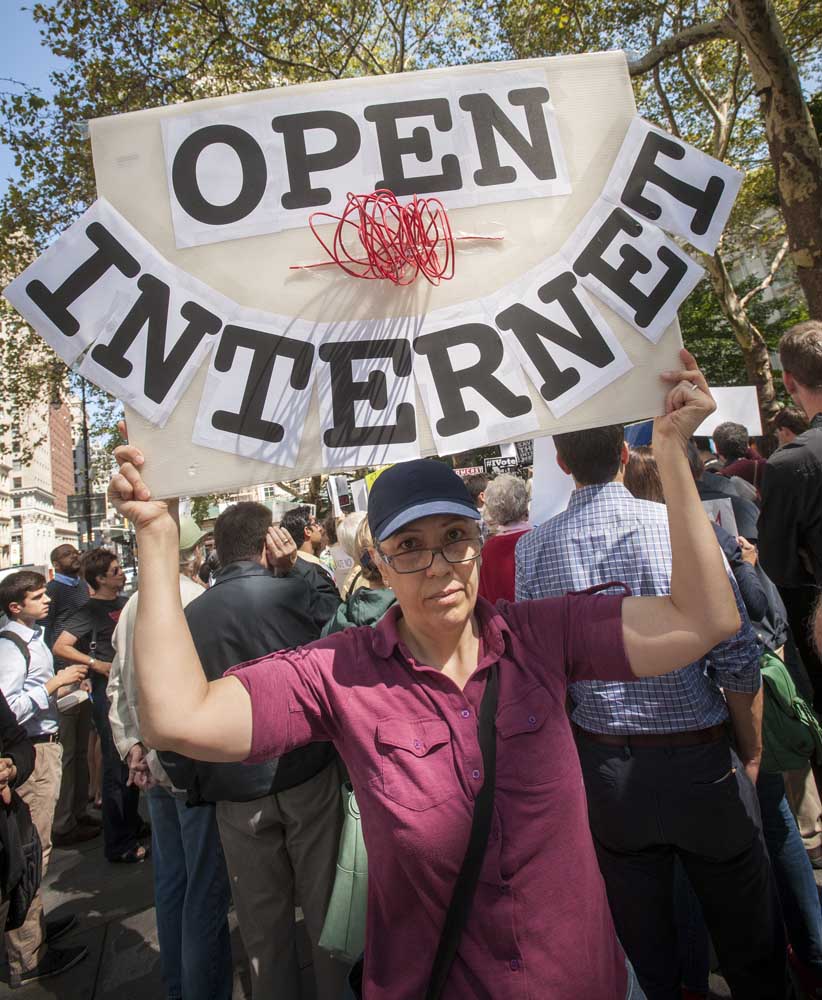Network neutrality back in spotlight
Published 7:23 pm Wednesday, May 17, 2017

- Activists protest outside of city hall in New York on Sept. 15, 2014 to demand protections for net neutrality. (Richard B. Levine/Sipa USA/TNS)
WASHINGTON — It began as an academic subject with a wonky name — network neutrality.
But at its heart, the issue was simple: Internet service providers should treat content equally.
Within a few years, the phrase — shortened to the slightly less-wonky net neutrality — became a rallying cry for Silicon Valley technology companies, liberals and online free-speech advocates.
For broadband companies and free-market conservatives, net neutrality became code for a government meddling in the vibrant internet economy.
After bizarre pop-culture moments, three major court rulings and more than 4 million public comments (and counting) to federal regulators, the term has become part of the online and political lexicon.
The chairman of the Federal Communications Commission wants to dismantle tough net neutrality regulations enacted in 2015.
Ajit Pai, a Republican appointed to head the FCC by President Trump, is pushing the agency to repeal the tough regulatory oversight for internet service providers that Democrats approved in 2015 over the objections of the broadband industry.
Eight months before Harvard students started thefacebook.com, a young associate professor at the University of Virginia, Tim Wu, coined the phrase network neutrality in a student-run academic journal.
His paper pondered the “conflicts between the private interests of broadband providers and the public’s interest in a competitive innovation environment centered on the internet.”
For example, Wu discussed the possibility that cable companies could close off competition for certain internet services by limiting access to what applications could be used on their networks.
Wu proposed to strike a balance that would “forbid broadband operators, absent a showing of harm, from restricting what users do with their internet connection.” He would allow operators to manage technical aspects such as “bandwidth consumption” to keep the network operating properly.
The FCC’s four freedoms
The Republican-controlled FCC unanimously adopted four principles “to encourage broadband deployment and preserve and promote the open and interconnected nature” of the public internet.
Later to be known as the four freedoms, they were based on principles outlined in a 2003 speech by former FCC Chairman Michael Powell, a Republican, and said that consumers were entitled to:
• Access the lawful content of their choice
• Run applications and services of their choice
• Connect their choice of legal devices that do not harm the network
• Have competition among network, application and content providers
Among the concerns at the time were restrictions by cable companies on customer use of virtual private networks and Wi-Fi. But he said the case for government regulations was “unconvincing and speculative.”
In its 2005 vote, taken after Powell left the agency, the FCC did not adopt net neutrality rules but said it would incorporate the principles in its policymaking.
Obama weighs in
Obama had been an early supporter of net neutrality. In 2007, he was one of 11 senators who signed on as co-sponsor of a bill to write net neutrality protections into federal law.
Obama touted his support for net neutrality during the 2008 campaign, in contrast to the opposition of his opponent, Sen. John McCain, R-Ariz.
In a two-page statement and an online video, Obama pushed the FCC to enact the toughest regulations by reclassifying broadband providers for utility-like oversight.
The debate over net neutrality raged online and in Washington. Sen. Ted Cruz, R-Texas, said tough net neutrality regulations were “Obamacare for the internet.”
On Feb. 4, 2015, then-FCC chairman Tom Wheeler released a revised proposal that prohibited broadband companies from blocking websites, slowing connection speeds and charging for faster delivery of content.
Net neutrality supporters cheered Wheeler’s revised proposal and jubilantly packed the FCC’s meeting room the day of the vote.
The regulations were approved along party lines by a 3-2 vote that installed the once-arcane concept of net neutrality as a guiding government doctrine for broadband networks.
AT&T Inc. joined other telecom companies and industry trade groups in suing the FCC, saying it overstepped its authority in classifying broadband service for utility-like regulation.
In June 2016, a federal appeals court panel dismissed the suit.
Less than five months later, Americans elected Republican Donald Trump as president. In 2014, he had slammed Obama’s plan as “another top-down power grab.” Now Trump was in position to install a new FCC chairman.
GOP seeks a blocked shot
Pai, who Trump appointed as chairman, is fond of using plain language to describe complex telecommunications issues. After the election, Pai said the FCC needed to “fire up the weed whacker” to slash unnecessary regulation. Net neutrality was the biggest weed on his list.
On April 26, he announced that he intended to push the FCC to rescind the utility-like oversight of broadband providers.
“At the FCC, we can correct a past mistake by moving away from government control of the internet,” Pai wrote. “And that’s exactly what we intend to do.”






